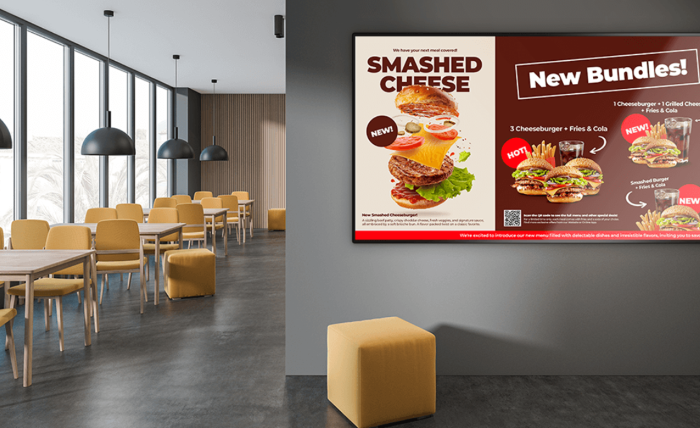The food and beverage industry is witnessing an unprecedented shift towards digital technology. Among the various technological advancements, the integration of electronic menu boards in restaurants has emerged as a significant game-changer in enhancing customer experience and streamlining operations. This article delves into the transformation of traditional restaurant menus through the adoption of electronic menu boards, highlighting the benefits and best practices in modern dining experiences.
Understanding Electronic Menu Boards
Electronic menu boards are digital displays used in restaurants and cafes to showcase menus, promotions, and other relevant content. These sophisticated systems have replaced the traditional paper menus and static signboards, offering a dynamic and interactive platform for restaurant owners to communicate with their customers.
The Advantages of Switching to Electronic Menu Boards
One of the primary benefits of integrating electronic menu boards is the ease of updating menu items, prices, and specials in real-time. This flexibility allows establishments to respond quickly to changes in inventory or promotional activities without incurring the cost or waste associated with reprinting traditional menus. Furthermore, the visual appeal of digital displays, with their vibrant images and animations, can entice customers, potentially increasing sales of featured items.
Another advantage is the operational efficiency gained through automation. Electronic menu boards can be programmed to display different menus based on the time of day, such as breakfast, lunch, or dinner services, streamlining the process for both customers and staff. Additionally, digital boards can integrate with point-of-sale (POS) systems, inventory management, and even customer loyalty programs to provide a seamless service experience.
Enhancing Customer Experience with Digital Displays
Moreover, digital menus can provide detailed descriptions and allergen information, which helps customers with dietary restrictions and contributes to a more inclusive dining environment. QR code stickers can also be incorporated into digital displays, allowing customers to access additional information, promotions, or even place orders directly from their smartphones, further improving convenience and engagement.
The customer experience is significantly enhanced by the use of electronic menu boards. With screens displaying crisp, high-resolution images of dishes, customers are better informed about their options, making it easier for them to make a decision. Moreover, digital menus can provide detailed descriptions and allergen information, which helps customers with dietary restrictions and contributes to a more inclusive dining environment.
Electronic Menu Boards and Environmental Responsibility
Limiting paper waste by eliminating the need for printed menus signals a restaurant’s commitment to sustainability. Electronic menu boards promote an environmentally-friendly approach that appeals to eco-conscious consumers and aligns with global efforts to reduce deforestation and waste.
Best Practices in Implementing Electronic Menu Boards
To maximise the impact of electronic menu boards, restaurants should focus on several key factors. The design and layout of the digital menu must be clear and easy to read, ensuring that texts and images are well-spaced and legible from a distance. Highlighting bestsellers and profitable items strategically can influence customer choices and boost sales.
Consistency in branding across all digital signage, including electronic menu boards, is also crucial. It ensures a seamless visual experience that aligns with the restaurant’s identity and branding efforts. To ensure such consistency and professional presentation, it’s advisable to work with experts like JDS & Menu Boards, who specialise in providing tailored digital signage solutions to the hospitality industry.
The placement of electronic menu boards must also be carefully considered. Screens should be positioned at eye level in areas with high visibility, such as near the entrance or above the ordering counter, to capture customers’ attention effectively.
Incorporating Technology Beyond Menus
Restaurants are also exploring additional functionalities of electronic menu boards, such as integrating them with social media feeds, running marketing content, and displaying real-time customer reviews. These interactive features add value to the customer’s dining experience and can create a sense of community and engagement within the establishment.
Connectivity with mobile applications and the use of QR codes on digital displays can offer customers a more interactive experience. They can place orders, access special offers, or join loyalty programs directly from their smartphones, which not only enhances convenience but also reduces perceived waiting times.
The Future of Dining with Electronic Menu Boards
The adoption of electronic menu boards is not a fleeting trend but a long-term evolution in the restaurant industry. As businesses adapt to the ever-changing landscape, staying ahead of the curve with modernised solutions such as led signs newcastle, is imperative for success. By embracing this technology, restaurants are not only optimising their operational prowess but also enriching the overall customer experience.
Furthermore, advanced analytics offered by digital signage systems provide valuable insights into customer preferences and behaviour. This data enables restaurants to make informed decisions on menu adjustments, promotional strategies, and even interior design choices.
Conclusion
Electronic menu boards stand at the forefront of modernising the traditional dining experience. They extend far beyond mere aesthetic upgrades, offering tangible benefits in operational efficiency, customer satisfaction, and environmental responsibility. As the world increasingly embraces digital solutions, restaurants that adapt to these changes will find themselves better equipped to meet the demands of today’s tech-savvy clientele.
Whether you operate a small local cafe or a large chain of eateries, the integration of electronic menu boards into your service model is a strategic move that can yield substantial returns. Partnering with a knowledgeable and experienced provider such as JDS & Menu Boards can ensure that the transition to digital is a seamless and successful endeavour for your establishment.
Embracing digital innovation with led signs newcastle not only propels restaurants towards a future-proof business model but also enhances the dining experience, meeting the high expectations of modern customers. As the culinary landscape continues to evolve, those who adopt electronic menu boards will likely find themselves at the leading edge of the industry.

